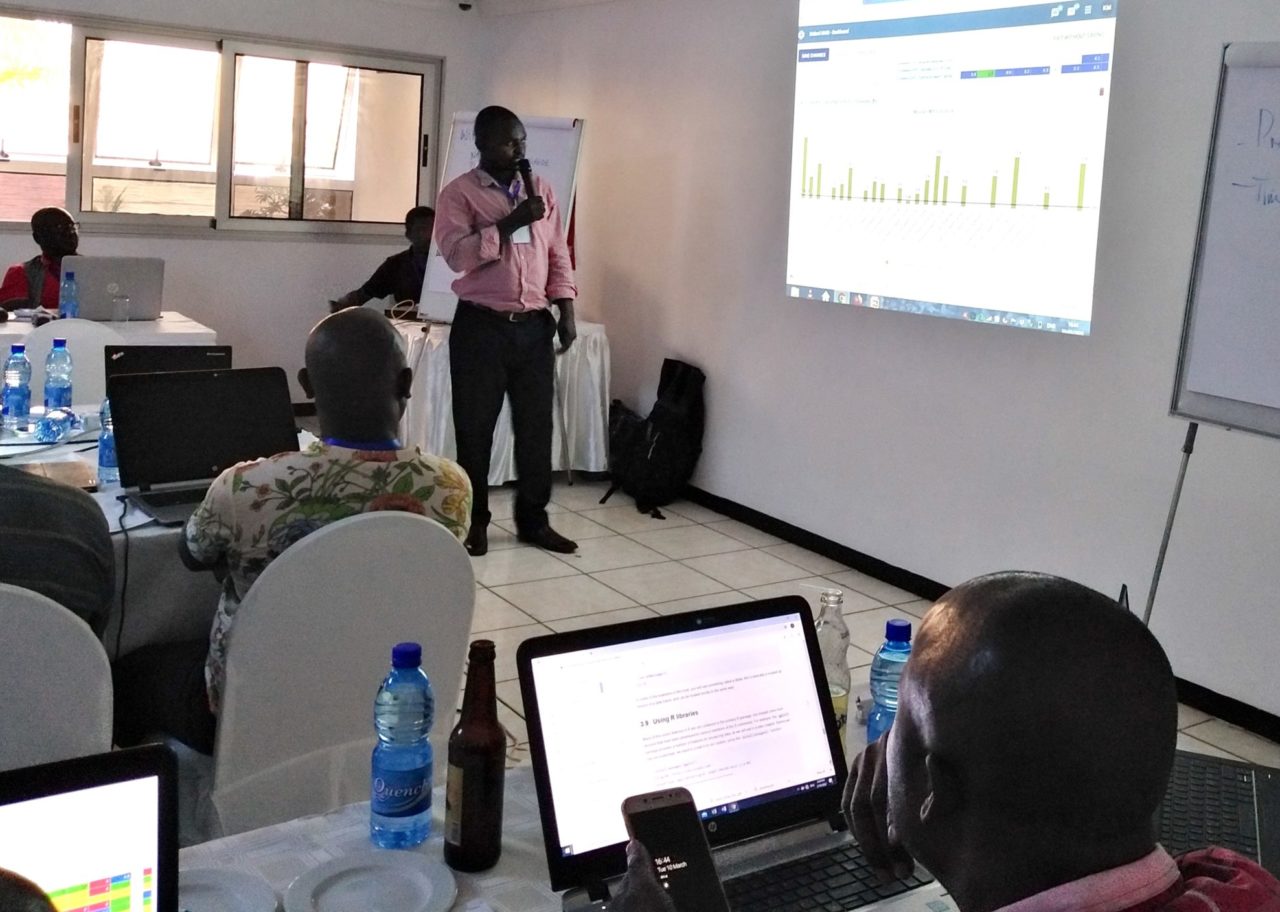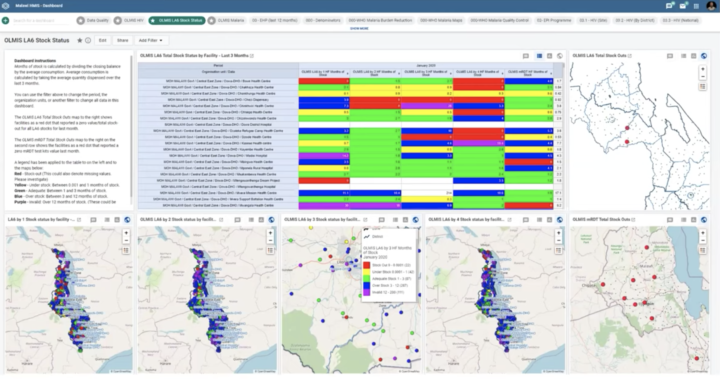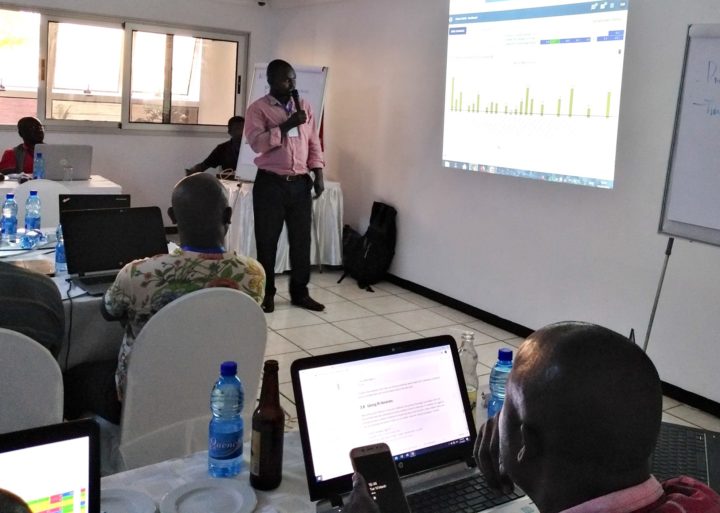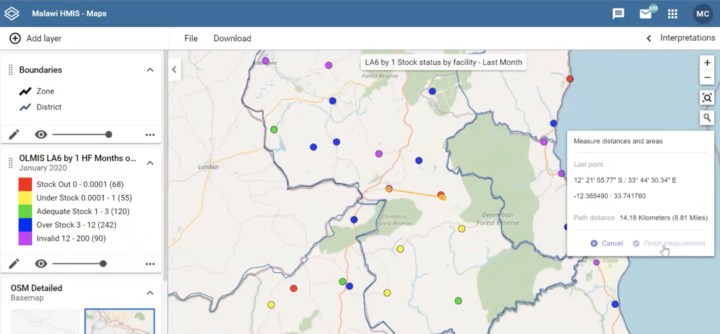
Integrating HMIS and eLMIS systems for better decision making in Malawi
Malawi used an interoperability layer to bring data from OpenLMIS into DHIS2 to facilitate composite analysis of stock and health data to support effective logistics planning
In Malawi, health program data and medical stock data are captured in different systems. DHIS2 has been used by the Ministry of Health since 2012 (when it replaced the original DHIS system) as their Health Management Information System (HMIS), their main data collection and aggregation tool and national repository for health data. Meanwhile, OpenLMIS is used as an electronic Logistics Management Information System (eLMIS) for collecting and managing data on medical stocks down to the facility level. Prior to their integration, these systems did not share data with each other, making it more difficult to combine data from both sources for effective health program management and evidence based decision support.
The Ministry of Health recognized the value in bringing the data from these systems together. Working in collaboration with several partners and stakeholders, they embarked on a yearlong project to integrate their HMIS and eLMIS systems. The ultimate goal of this effort was to facilitate evidence-based decision making by health and logistics teams down to the district and facility level, by providing access to combined data from both systems presented in user-friendly dashboards built around key indicators. While Malawi’s DHIS2-based HMIS includes data from more than 60 health programs, the primary focus of this integration project was HIV, Tuberculosis, and Malaria.

Successful system integration starts with a good plan
Before the technical work of integrating DHIS2 and OpenLMIS could begin, it was necessary to bring together stakeholders from both the health and logistics teams, as well as other experts, to define project goals at a high level, assess the possibilities for integration, and plan the specific outputs — such as Key Performance Indicators (KPIs) — that were required from the resulting system, to ensure that the system design supported the information needs of the various programs and stakeholders. Malawi’s Ministry of Health was the primary stakeholder in this project, and was supported by partners including the University of Oslo and HISP Malawi for DHIS2 technical requirements, GHSC-PSM for OpenLMIS technical requirements, and Kuunika Data for Action (a project funded by The Bill and Melinda Gates Foundation) for development of the interoperability layer. The implementation was financed by The Global Fund.
The project kicked off in October 2018, and proceeded through the following phases during the 14 months from start to finish, when the integrated system became operational in December 2019:
- Readiness assessments
- Development of KPIs across programs
- Indicator mapping and documentation (in both DHIS2 and OpenLMIS)
- Development of Interoperability Layer, Master Facility Registry and Product Catalog
- Development of the API for LMIS/DHIS Integration
- User Acceptance testing for integration
- Configuration of Indicators
- DHIS2/LMIS Integration complete
Once system interoperability was achieved, data from OpenLMIS could be sent to DHIS2 via an interoperability layer developed using OpenHIM (an open-source mediator platform), based on guidelines from OpenHIE. DHIS2 then becomes the final destination for both logistics and health data for analysis and program management. Some examples of KPIs output from the integrated HMIS-eLMIS system are: caseload to commodity consumption ratio, caseload to stock on hand, average monthly commodity consumption, and estimate of adequate stock levels per facility (to show which facilities are adequately, under- or overstocked). Because of the nature of LMIS indicators, it was necessary to upgrade Malawi’s DHIS2 system to version 2.32 to make use of predictors, which were not available in previous versions of DHIS2. The OpenLMIS API was also updated to support this integration project.
Testing began in October 2019, along with configuration of predictor-dependent indicators. Integration was complete in December 2019 when Malawi’s system was successfully able to push data from OpenLMIS to DHIS2.

Good data use depends on good tools, and the skills to use them
Following the integration of the HMIS-LMIS system and configuration of dashboards, one important task remained: building the capacity of staff who would be using these dashboards and to make evidence-based decisions. To help guide dashboard use, interpretations were added in DHIS2 to make it easier for users to understand and use the data outputs. The final part of the process was a DHIS2 Academy on Logistics Data Integration, that was scheduled to be held in Malawi in May 2020, to be followed by district-level trainings. Unfortunately, the Academy and district level trainings were postponed due to the COVID-19 pandemic. A national training on system use was carried out in March 2020 with support from HISP Malawi, and a digital version of the DHIS2 Logistics Academy was held online in November 2020, giving partners from Malawi the opportunity to present their work on this project to a global audience of DHIS2 implementers and experts.
Once trained on the system, users are able to use DHIS2’s dynamic analytics tools to review the combined LMIS and HMIS data. For example, a map in DHIS2 can quickly show which facilities are over- and under-stocked for specific supplies and calculate the distance between them, helping facilitate decision making about potential stock transfers to prevent or remedy critical shortages. Comparison of key indicator ratios to targets has also helped to identify potential irregularities in specific facilities. Further review and investigation has subsequently revealed some stock management practices that were contributing to inaccurate stock status such as holding too much stock on hand at the dispensary (on shelf availability) which is not reflected in the final stock status.

In reflecting on this project, the team identified some key lessons learned. First, that interoperability is complex, and preparatory work in both the source and target systems — in this case OpenLMIS and DHIS2 — is required to ensure that they can be connected, including a check for compliance with interoperability layer (such as OpenHIM) if a mediator will be used. Second, that the integration project does not end with the initial launch of the system, as real-world changes like the opening and closing of health facilities and changes to products in the supply inventory require maintenance to the HMIS and LMIS systems so that corresponding changes are reflected in the master facility list and product registry.
Repurposing the interoperability layer for COVID-19 laboratory data
While the onset of the COVID-19 pandemic in early 2020 disrupted Malawi’s plans for rollout of their integrated HMIS and LMIS system, it also created a new and pressing need for system integration. Malawi’s health authorities decided to use DHIS2 for COVID-19 surveillance and response as part of their DHIS2-based One Health Surveillance Platform. However, the laboratories responsible for processing COVID-19 tests used other Lab Management Information Systems to track sample information and test results. Using the OpenHIM mediator, the team from Kuunika Data for Action was able to integrate these systems, so that COVID-19 suspected cases and test sample data could be registered in DHIS2 Tracker, test information could be passed to the labs electronically, and test results could be passed back to DHIS2, where they could be used for statistical analysis and to notify the patient of their results. This integration greatly reduced the logistical costs of sending test information to the labs, and increased data quality and integrity in the testing process. The Kuunika Data for Action team presented this project at the DHIS2 Annual Conference in 2020:


